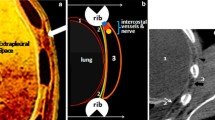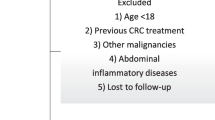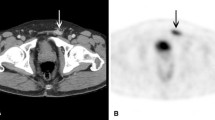Abstract
Objective
We describe FDG-PET/CT findings of postoperative fat necrosis in patients following abdominal surgery, and evaluate their changes in size and FDG uptake over time.
Methods
FDG-PET/CT scans from January 2007–January 2016 containing the term ‘fat necrosis’ were reviewed. Lesions meeting radiological criteria of fat necrosis in patients with prior abdominal surgery were included.
Results
Forty-four patients, 30 males, mean age 68.4 ± 11.0 years. Surgeries: laparotomy (n=37; 84.1 %), laparoscopy (n=3; 6.8 %), unknown (n=4; 9.1 %). CTs of all lesions included hyperdense well-defined rims surrounding a heterogeneous fatty core. Sites: peritoneum (n=34; 77 %), omental fat (n=19; 43 %), subcutaneous fat (n=8; 18 %), retroperitoneum (n=2; 5 %). Mean lesion long axis: 33.6±24.9 mm (range: 13.0–140.0). Mean SUVmax: 2.6±1.1 (range: 0.6–5.1). On serial CTs (n=34), lesions decreased in size (p=0.022). Serial FDG-PET/CT (n=24) showed no significant change in FDG-avidity (p=0.110). Mean SUVmax did not correlate with time from surgery (p=0.558) or lesion size (p=0.259).
Conclusion
Postsurgical fat necrosis demonstrated characteristic CT features and may demonstrate increased FDG uptake. However, follow-up of subsequent imaging scans showed no increases in size or FDG-avidity. Awareness of this entity is important to avoid misinterpretation of findings as recurrent cancer.
Key Points
• Postsurgical fat necrosis may mimic cancer in FDG-PET/CT.
• Follow-up of fat necrosis showed no increase in FDG intensity.
• CT follow-up showed a decrease in lesion size.
• FDG uptake did not correlate with time lapsed from surgery.






Similar content being viewed by others
Abbreviations
- CT:
-
Computed tomography
- FDG:
-
Fluorodeoxyglucose
- PET:
-
Positron emission tomography
- SUV:
-
Standardized uptake values
References
Kamaya A, Federle MP, Desser TS (2011) Imaging manifestations of abdominal fat necrosis and its mimics. Radiographics 31:2021–2034
Tan PH, Lai LM, Carrington EV et al (2006) Fat necrosis of the breast--a review. Breast 15:313–318
Aydin D, Berg JO (2016) Subcutaneous encapsulated fat necrosis. Clin Case Rep 4:456–457
Shaaban AM, Rezvani M, Tubay M, Elsayes KM, Woodward PJ, Menias CO (2016) Fat-containing retroperitoneal lesions: Imaging characteristics, localization, and differential diagnosis. RadioGraphics 36:710–734
Kiryu H, Rikihisa W, Furue M (2000) Encapsulated fat necrosis – a clinicopathological study of 8 cases and a literature review. J Cutan Pathol 27:19–23
Biondi A, Fico V, Marra AA, Persiani R (2016) Encapsulated Fat Necrosis Mimicking an Intra-abdominal Tumor. J Gastrointest Surg. https://doi.org/10.1007/s11605-016-3263-3
Hsieh CJ, Wang PW, Chen TY (2014) The relationship between regional abdominal fat distribution and both insulin resistance and subclinical chronic inflammation in non-diabetic adults. Diabetol Metab Syndr 6:49
Goo JM, Im JG, Do KH et al (2000) Pulmonary tuberculoma evaluated by means of FDG PET: findings in 10 cases. Radiology 216:117–121
Balink H, Tan SS, Veeger NJ et al (2015) 18F-FDG PET/CT in inflammation of unknown origin: a cost-effectiveness pilot-study. Eur J Nucl Med Mol Imaging 42:1408–1413
Kalicke T, Schmitz A, Risse JH et al (2000) Fluorine-18 fluorodeoxyglucose PET in infectious bone diseases: results of histologically confirmed cases. Eur J Nucl Med 27:524–528
Davidson T, Klang E, Goshen E (2017) Postoperative changes after surgical mesh hernia repair: a pitfall in interpretation of 18F-FDG PET-CT. Hernia. https://doi.org/10.1007/s10029-017-1596-9
Kisielinski K, Cremerius U, Reinartz P et al (2003) Fluordeoxyglucose positron emission tomography detection of inflammatory reactions due to polyethylene wear in total hip arthroplasty. J Arthroplast 18:528–532
Bhargava P, Zhuang H, Kumar R et al (2004) Iatrogenic artifacts on whole-body F-18 FDG PET imaging. Clin Nucl Med 29:429–439
Harrigal C, Branstetter BF 4th, Snyderman CH et al (2005) Teflon granuloma in the nasopharynx: a potentially false-positive PET/CT finding. AJNR Am J Neuroradiol 26:417–420
Modi D, Fulham MJ, Mohamed A et al (2005) Markedly increased FDG uptake in a vocal cord after medialization with Teflon: PET/CT findings. Clin Nucl Med 30:45–47
Chen MY, Ng KK, Ma SY et al (2005) False-positive fluorine-18 fluorodeoxy-D-glucose positron emission tomography imaging caused by retained gauze in a woman with recurrent ovarian cancer: a case report. Eur J Gynaecol Oncol 26:451–453
Miyake KK, Nakamoto Y, Mikami Y et al (2010) F-18 FDG PET of foreign body granuloma: pathologic correlation with imaging features in 3 cases. Clin Nucl Med 35:853–857
Rehák Z, Szturz P, Krejčí E et al (2012) FDG-PET-positive foreign-body granuloma mimicking residual germinal tumor infiltration. Clin Nucl Med 37:790–792
Ulaner GA, D'Andrea G, Cody HS 3rd (2013) Breast implant foreign body reaction mimicking breast cancer recurrence on FDG PET/CT. Clin Nucl Med 38:480–481
Luo J, Mao Y, Cai S et al (2014) Post-nephrectomy foreign-body granuloma in the retroperitoneum mimicking lymph node metastasis of renal cell cancer. Onco Targets Ther 7:2137–2141
Metser U, Miller E, Lerman H, Even-Sapir E (2007) Benign nonphysiologic lesions with increased 18F-FDG uptake on PET/CT: characterization and incidence. AJR Am J Roentgenol 189:1203–1210
Dubreuil J, Moreau A, Sarkozy C (2016) FDG PET/CT Findings in Abdominal Fat Necrosis After Treatment for Lymphoma. Clin Nucl Med 41:397–398
Seo YY, Yoo IR, Hyun OJ, Kim SH, Chung SK (2010) FDG Uptake in Fat Necrosis Following Transverse Rectus Abdominis Myocutaneous (TRAM) Flap Reconstructed Breasts: 3 Cases. Clin Nucl Med 35:283–285
Dobbs NB, Latifi HR (2013) Diffuse FDG uptake due to fat necrosis following transverse rectus abdominus myocutaneous (TRAM) flap reconstruction. Clin Nucl Med 38:652–654
Akkas BE, Ucmak Vural G (2013) Fat necrosis may mimic local recurrence of breast cancer in FDG PET/CT. Rev Esp Med Nucl Imagen Mol 32:105–106
Kashyap R, Lau E, George A et al (2013) High FDG activity in focal fat necrosis: a pitfall in interpretation of posttreatment PET/CT in patients with non-Hodgkin lymphoma. Eur J Nucl Med Mol Imaging 40:1330–1336
Belakhlef A, Jani C, Church C, Fraser R, Lakhanpal S (2008) Fat necrosis mimicking B-cell lymphoma: a PET/CT and FDG study. Clin Nucl Med 33:271–272
Adejolu M, Huo L, Rohren E, Santiago L, Yang WT (2012) False-Positive Lesions Mimicking Breast Cancer on FDG PET and PET/CT. AJR Am J Roentgenol 198:W304–W314
Lee SA, Chung HW, Cho KJ et al (2013) Encapsulated fat necrosis mimicking subcutaneous liposarcoma: radiologic findings on MR, PET-CT, and US imaging. Skelet Radiol 42:1465–1470
Dubreuil J, Moreau A, Sarkozy C, Traverse-Glehen A, Skanjeti A, Salles G, Giammarile F (2016) FDG PET/CT Findings in Abdominal Fat Necrosis After Treatment for Lymphoma. Clin Nucl Med 41:397–398
Thurnher MM, Schima W, Turetschek K, Thurnher SA, Függer R, Oberhuber G (2001) Peripancreatic fat necrosis mimicking pancreatic cancer. Eur Radiol 6:922–925
Reddy MP, Sangster G, Heldmann MG, Lilien DL (2006) Fat necrosis in the abdomen after surgery close to the pancreas: Potential false-positive o npositron emission tomography. Clin Nucl Med 31:499–500
Goshen E, Davidson T, Aderka D, Zwas ST (2006) PET/CT detects abdominal wall and port site metastases of colorectal carcinoma. Br J Radiol 79:572–577
Chan LP, Gee R, Keogh C, Munk PL (2003) Imaging Features of Fat Necrosis. AJR Am J Roentgenol 181:955–959
Kiryu H, Rikihisa W, Furue M (2000) Encapsulated fat necrosis - a clinicopathological study of 8 cases and a literature review. J Cutan Pathol 27:19–23
Rydzak C, Chauhan A, Gupta N, Chuang HH, Rohren EM, Bhosale PR (2016) Fat-containing hypermetabolic masses on FDG PET/CT: a spectrum of benign and malignant conditions. AJR Am J Roentgenol 207:1095–1104
Acknowledgements
An abstract of this work has been submitted for presentation at RSNA 2017 (Radiologic Society of North America).
Funding
The authors state that this work has not received any funding.
Author information
Authors and Affiliations
Corresponding authors
Ethics declarations
Guarantor
The scientific guarantor of this publication is Dr. Tima Davidson.
Conflict of interest
The authors of this manuscript declare no relationships with any companies whose products or services may be related to the subject matter of the article.
Statistics and biometry
One of the authors has significant statistical expertise.
Informed consent
Written informed consent was waived by the Institutional Review Board.
Ethical approval
Institutional Review Board approval was obtained.
Methodology
• retrospective
• case-control study
• performed at one institution
Rights and permissions
About this article
Cite this article
Davidson, T., Lotan, E., Klang, E. et al. Fat necrosis after abdominal surgery: A pitfall in interpretation of FDG-PET/CT. Eur Radiol 28, 2264–2272 (2018). https://doi.org/10.1007/s00330-017-5201-5
Received:
Revised:
Accepted:
Published:
Issue Date:
DOI: https://doi.org/10.1007/s00330-017-5201-5




